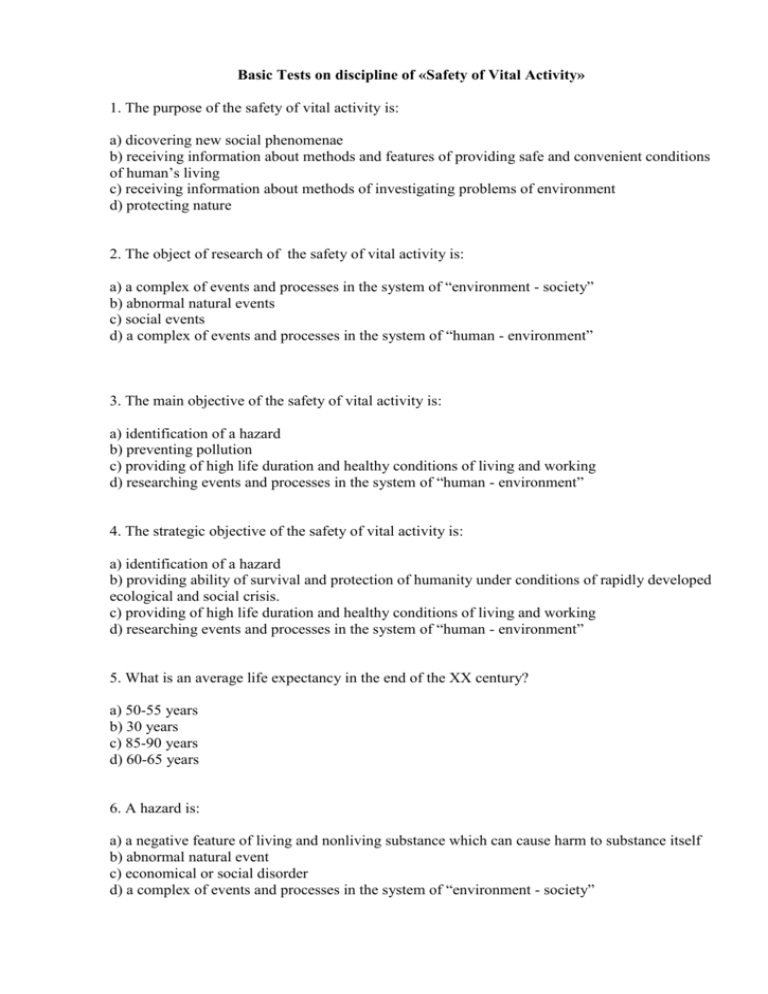Safety of Vital Activity
advertisement

Basic Tests on discipline of «Safety of Vital Activity» 1. The purpose of the safety of vital activity is: a) dicovering new social phenomenae b) receiving information about methods and features of providing safe and convenient conditions of human’s living c) receiving information about methods of investigating problems of environment d) protecting nature 2. The object of research of the safety of vital activity is: a) a complex of events and processes in the system of “environment - society” b) abnormal natural events c) social events d) a complex of events and processes in the system of “human - environment” 3. The main objective of the safety of vital activity is: a) identification of a hazard b) preventing pollution c) providing of high life duration and healthy conditions of living and working d) researching events and processes in the system of “human - environment” 4. The strategic objective of the safety of vital activity is: a) identification of a hazard b) providing ability of survival and protection of humanity under conditions of rapidly developed ecological and social crisis. c) providing of high life duration and healthy conditions of living and working d) researching events and processes in the system of “human - environment” 5. What is an average life expectancy in the end of the XX century? a) 50-55 years b) 30 years c) 85-90 years d) 60-65 years 6. A hazard is: a) a negative feature of living and nonliving substance which can cause harm to substance itself b) abnormal natural event c) economical or social disorder d) a complex of events and processes in the system of “environment - society” 7. Which of those factors doesn’t cause a hazard? a) global changing of environment b) researching new kinds of medicine c) introduction of new technologies d) appearance of new causes of environmental pollution 8. Which of those terms isn’t a kind of hazard? a) natural b) social/political; c) informational d) natural-technogenic 9. Which of those factors natural hazards aren’t dependent on? a) natural conditions b) ground relief c) introduction of new technologies d) climatic conditions 9. What is technosphere? a) artificial environment b) ground relief c) a negative feature of living and nonliving substance which can cause harm to substance itself d) appearance of new causes of environmental pollution 10. What is WHO? a) Worldwide Hockey Organization b) Wifehood Organization c) Wild Horse Operators d) World Health Organization 11. Risk is: a) global changing of environment b) appearance of new causes of environmental pollution c) a negative feature of living and nonliving substance which can cause harm to substance itself d) a relation of number of actual occurrence of a hazard to their theoretically possible number during a certain period of time 12. Social systems are: a) groups of people b) kinds of artificial environment c) systems of abnormal natural events d) social and technical events 13. Which of those things can’t be a part of biological system? a) human b) technical device c) fungus d) amphibian 14. An ergotic system is: a) systems of abnormal natural events b) a kind of artificial environment c) A system which has a human as one of its elements d) a complex of events and processes in the system of “environment - society” 15. Technical environment consists of: a) systems of abnormal natural events b) accommodation, vehicles, industrial and energetic objects, weapons c) forms of common activity of people d) soil, air, water, plants and animals, planets etc 16. Social environment consists of: a) systems of abnormal natural events b) accommodation, vehicles, industrial and energetic objects, weapons c) forms of common activity of people d) soil, air, water, plants and animals, planets etc 17. Home environment is: a) a human’s environment that consists of inhabited buildings b) a kind of natural environment c) a system which has a human as one of its elements d) soil, air, water, plants and animals, planets etc 18. Home environment is: a) a human’s environment that consists of inhabited buildings b) a kind of natural environment c) a system which has a human as one of its elements d) soil, air, water, plants and animals, planets etc 19. Which is not a stage of stress response: a) Behavioral b) Technical c) Autonomic d) Exhaustion 20. Which are the main characteristics of acute stress? a) alarm reaction, quick recovery, possibility of saving your life b) slow recovery, repeated stress c) only qiuck recovery d) emotional boost 21. Which are the main characteristics of chronic stress? a) alarm reaction, quick recovery, possibility of saving your life b) slow recovery, emotional boost c) constant stress, no recovery, impairing immunity or general health d) alarm reaction, no recovery, possibility of saving your life 22. Which are consequences of recovery from stress? a) illness b) death c) perpetual of illness d) all the variants are correct 23. Which is the main structure working during stress? a) peripheral nervous system b) HPAA c) thyroid metabolism d) “b” and “c” are correct 24. A phenomena of stess paradox characterises by: a) pathological chages in immute system b) pushing the body into overt desease c) has positive affect on the organism d) no correct answer







